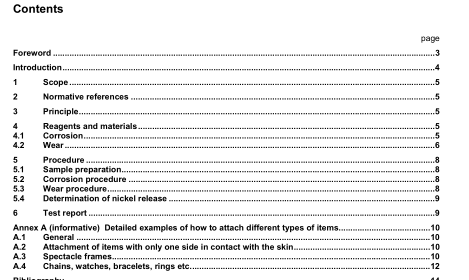EN 12472:2005 – Method for the simulation of wear and corrosion for the detection of nickel release from coated items

1 Scope
This European Standard specifies a method for accelerated wear and corrosion, to be used prior to the detection of nickel release from coated items that come into direct and prolonged contact with the skin.
2 Normative references
The following referenced documents are indispensable for the application of this European Standard. For dated references, only the edition cited applies. For undated references, the latest edition of the referenced document (including any amendments) applies.
EN 1811, Reference test method for release of nickel from products intended to come into direct and prolonged contact with the skin
3 Principle
The items to be tested are exposed to a corrosive atmosphere before being placed into a tumbling barrel together with a wear medium of abrasive paste and granules. The barrel is rotated so as to subject the test pieces to wear from the wear medium. The items are then tested for nickel release in accordance with EN 1811.
4 Reagents and materials
Except where indicated, all reagents and materials that can come into contact with samples or reagents shall be demonstrably free of nickel, and all reagents shall be of recognized analytical grade or better.
4.1 Corrosion
4.1.1 Container
Container with a lid and a device for suspending the test pieces, all parts made of inert material (e.g. glass or plastic).
4.1.2 Corrosive medium
Dissolve 50 g DL-lactic acid, > 85 % purity, and 100 g sodium chloride in 1 000 ml de-ionized water.
4.1.3 Degreasing solution
An appropriately diluted, neutral, commercially available detergent shall be used, for example, a 0,5 % aqueous solution of sodium dodecylbenzene sulfonate.
4.1.4 De-ionized water
De-ionized water, specific conductivity maximum 1 µS/cm.
4.1.5 Laboratory oven
Laboratory oven, capable of maintaining a temperature of (50 ± 2) °C.
4.2 Wear
4.2.1 Tumbling barrel and retaining assembly
The tumbling barrel and retaining assembly shall be in accordance with the following description:
barrel of hexagonal cross-section and internal diameter of 19 cm perpendicular distance between opposite sides designed to rotate around its axis which is orientated horizontally (see Figure 1);
retaining assembly, suitable for attaching the test items so that they do not come into contact with each other during tumbling;
retaining assembly, with items attached, shall be inserted into the barrel for tumbling.
NOTE Examples are given in Annex A of retaining assemblies suitable for attaching typical items.
EN 12472:2005 – Method for the simulation of wear and corrosion for the detection of nickel release from coated items